Introduction
San Francisco de Campeche City (Campeche, México) was founded in 1560 (Figure 1a, b y c). The city was characterized by an innovative military defense system that was designed to protect local governmental offices and Spanish colonial residences from the continuous pirate attacks that occurred during the 16th and 17th centuries. This urban system consisted of an irregular hexagon-shaped bastion-and-rampart fortified construction that surrounded the city's inner core. The San Carlos Bastion, built with local calcareous materials from the region,1 is located in the northwest corner of this military defense system (Figure 1b). Due to its proximity to the sea, most of the walls (except those on the south and southeast) suffered for a long time from the constant impact of waves and tidal movements. Today, the bastion remains under the influence of sea aerosol and local air pollution.
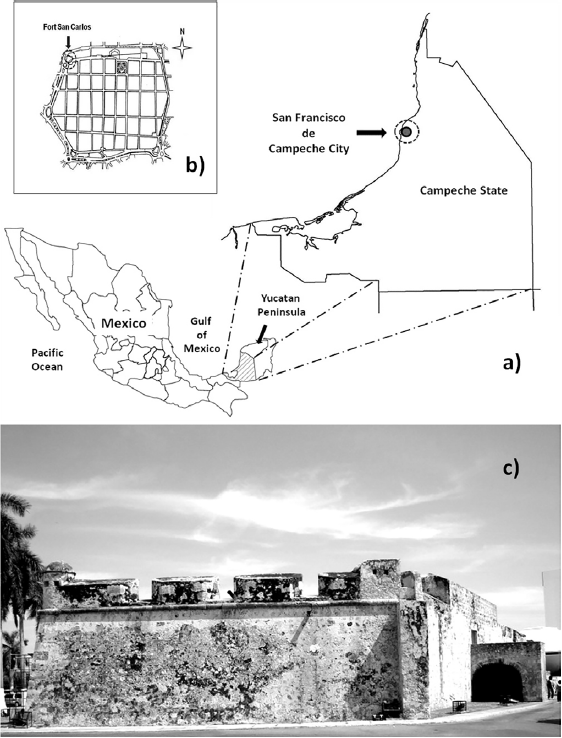
Figure 1 a) Location of San Francisco de Campeche (dotted circle) and Campeche State, in the Yucatan peninsula (southeastern Mexican Republic); b) San Francisco de Campeche historical urban core: the dotted circle indicates the location of San Carlos Bastion; c) San Carlos Bastion (Photograph: Javier Reyes, 2008).
Since its edification, the San Carlos Bastion has also been exposed to the action of tropical climate, which induced weathering. Up to now, very few systematic studies have been conducted to determine the specific causes of deterioration of San Francisco de Campeche's urban core (see e.g.Corvo 2010:205).
In a large body of literature, the degradation of limestone historic buildings in the tropical climate of Latin America has been associated with aggressive environmental conditions characterized by high relative humidity and long periods of warm temperatures during the summer and autumn; rainfall has also been identified as an important decay factor (see e.g.Webb 1992:165; Schiavon 2004:448; Bravo 2006:655). With recent exposure to natural or anthropogenic pollutants, the risk of alteration for limestone building materials increases (Corvo 2010:205; Newby 1991:347).
Limestone is a highly porous material. High water availability leads to ion exchange across the limestone's porous structure during wet/dry cycles in tropical environments. Water dynamics establish different equilibria between the stone and the atmosphere. The equilibria are functions of meteorological conditions that promote the dissolution and re-crystallization of salts. Condensed water facilitates the dissolution of pollutants and their chemical action on the stone. In urban polluted environments, the external surface of any building is unavoidably destined to be covered with layers that assume a grey to black color according to particular micro-environmental conditions (Baedecker 1992:147; Zappia 1998:235; Torres 2009).
The kinetics of capillary absorption and water desorption during drying is a key parameter that should be considered in understanding the mechanism of stone deterioration. The process of deterioration depends on temperature, relative humidity, evaporation rate, and on the intrinsic characteristics of the stone, including its physicochemical properties, structure and texture (Montana 2008:367).
As mentioned before, being a representative of the military style during the colonial period, the San Carlos Bastion is an irregular pentagonal-shaped building constructed using local calcareous materials: limestone blocks, sand, slake lime and carbonate clay marls2 (known as sascab or sahacab3 in the Yucatan Peninsula region). It has two watch towers, five corners and an access door made with quarried limestone blocks. The present paper analyses the weathering processes occurring at San Carlos Bastion. Decay pathologies presented in the building are studied using instrumental analytical techniques, in order to discuss the environmental processes that contribute to the weathering of the building.
Materials and Methods
Sampling
Eighteen representative samples were collected from different areas of San Carlos Bastion: five from the north wall (N), four from the west wall (W), five from the south and southeast walls (S-SE) and four from the east wall (E). Three kinds of samples were obtained: weathered stone, mortar samples and mortar over stone substrate with crust fragments.
Analytical techniques
Optical microscopy
In order to determine differences in sample texture, a surface microscopic description of each sample was carried out under a Stereo Microscope (Ironscope II), while stratigraphic images were obtained using an Axioscop 40 microscope (Carl Zeiss).
X-Ray diffraction (XRD)
After being ground and mounted in a silicon sample holder, a portion of each sample (0.1 g) was analyzed in a Bragg-Brentano geometry X-Ray diffractometer (Siemens D5000) with CuKɑ radiation (λ = 1.5418 Å) generated at 25 mA and 35 kV. The patterns were recorded in the 2-60° 2θ range using a step size of 0.02° and a step time of 10s.
SEM/EDS analysis
Fragments of 1 cm2 of each sample were examined without previous preparation in an Environmental Scanning Electron Microscope (Philips XL30 ESEM) coupled with an energy dispersive analytical system. The analysis was performed at 20 kV, with a working distance of 10 mm and a tilt angle of 0°. An X-Ray SUTW-Sapphire detector with resolution of 131 eV was used. The samples were fixed in the sample holder using carbon film.
Results and discussion
Weathering structures
Direct observation of the San Carlos Bastion showed water discharge structures widely distributed at different heights along the walls. The structures were round-to-oval shaped, forming cavities with diameter from 2 to 5 cm (Figure 2).
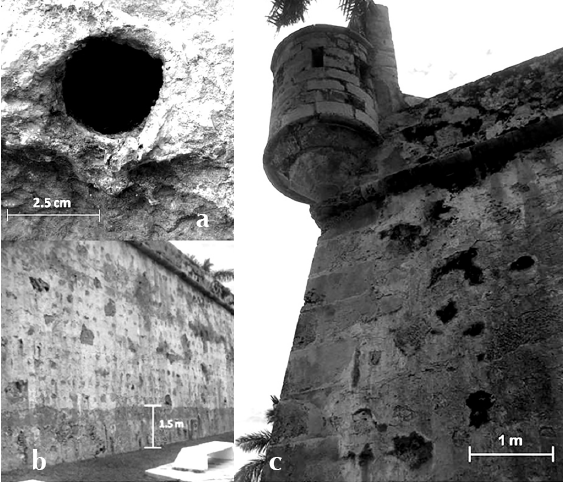
Figure 2 Different weathering effects at San Carlos Bastion: (a) Water discharge structures. Efflorescence and crust formation can be observed outside; (b) Alternation stripe observed at the north; (c) Preferential limestone quarry block degradation at west wall (Photograph: Javier Reyes, 2010).
During rainfall events, water flows from the roof across the inner masonry structure. The flowing water leads to dissolution processes of calcareous stone fragments, while their binders, also calcareous, drain outside the wall. Several dissolution structures form and neomineral CaCO3 crust crystalizes as a natural consequence of the acid hydrolysis of calcium carbonate induced by the CO2 content in water, according to the mechanisms described by Samaouali (2010:1171 [Figure 3]):

Figure 3 Acid hydrolysis of calcium carbonate induced by water content CO2, according to the mechanisms described by Huang (Source: Samaouali, 2010:1171).
Neominerals expand to form brown, grey or white deposits over mortars containing residues of pigments or over stone blocks without mortar. Moreover, hydration/dehydration cycles are favored by cyclic change on atmospheric humidity. The expansion of salts cause granular disaggregation and cracks on mortar and stone
The capillary action produced wet zones from the base of the walls up to a height of 1.20 meters where the binder content in the mortar was dissolved. Some areas of the building with modern cements -made using limestone, shells, chalk (CaSO4) or/and marl combined with shale, clay, slate, blast furnace slag, silica sand, and iron ore (PCA 2015)- suffered a similar process. This generated cracking, cavities, crumbling and disintegration, leaving the particulate materials in conditions to be removed by the fluvial and eolian erosion processes.
Biological activity
Many forms of biological weathering affect the stone and the mortar substrates in the San Carlos Bastion (Figure 4). In tropical climates, the high water availability allows the development of biological agents. Their role as damage agents depends on the metabolic activity of the organisms and the environmental conditions; for instance hyphae penetration causes disintegration and breakdown of stone and mortars structures, whereas lichens induce the formation of bio-mineralization byproducts because of organic acid secretions (Gehrmann 1992:37). Chromatic changes commonly cause the appearance of colored bio-deposits or patinas that affect the building's aesthetics. These chromatic changes, however, reduce the effect of water and wind erosion. Moreover, biological colonization expands and contracts according to water availability, causing disruptive forces in the wall components.4
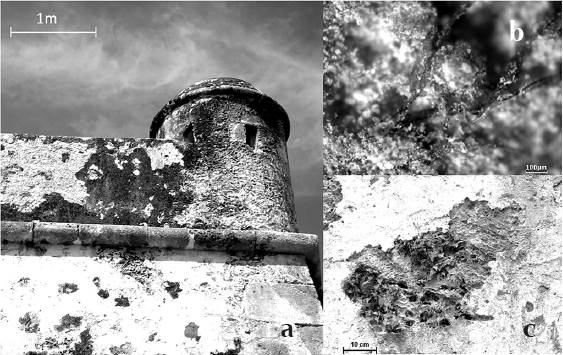
Figure 4 Biological activity at the San Carlos Bastion: (a) General view of biological colonization formed over east wall; (b) Mortar disintegration induced by hyphae penetration; (c) Mortar damage -consequence of biological activity- (Photograph: Javier Reyes, 2010).
Furthermore, sediments are deposited inside fissures and cavities -formed during karstification processes- by biological activities, wind and water flow. Inside, small plants and their roots produce dislocation and fracture leading to the formation of numerous sites for new plant growth (Figure 4). As a natural consequence, insects and birds also colonize the building.
Crusts morphology and elemental composition
Figure 5a shows an optical image (4X) from a typical crust, a sample obtained from external water discharge conducts; the results of EDS chemical analysis carried out in the 18 samples are synthetized in Figure 6.
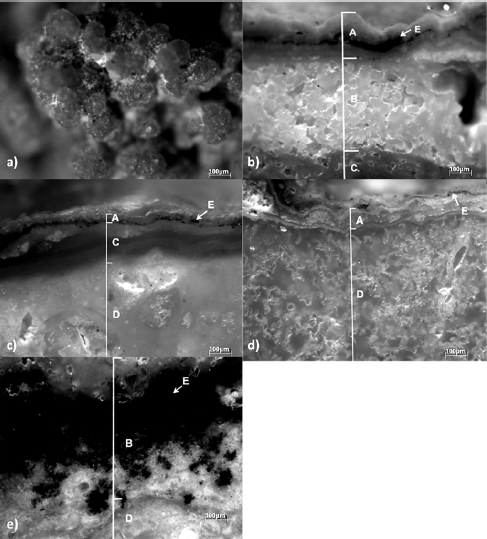
Figure 5 (a) Internal structure from a crust taken from outside water discharge conducts; (b and c) Cross sections (5X) of damaged layers from selected mortar samples. Cross sections (5X) of damaged layers of selected limestone samples (d and e) (Analysis: Isabel Silva-León, 2013).
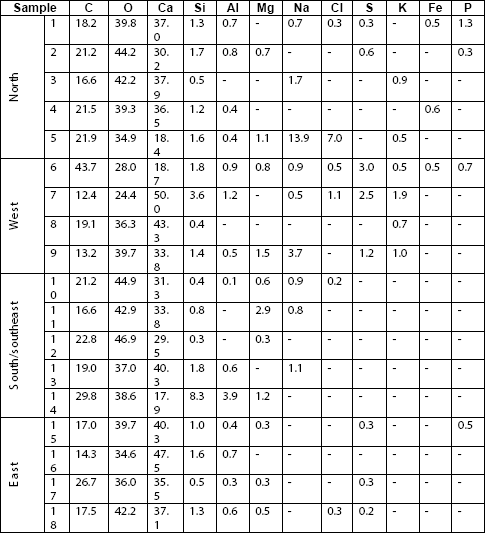
Elemental composition (% w) of samples from San Carlos Bastion.
Figure 6 Elemental composition (%) of samples from San Carlos Bastion: EDX (Analysis: Javier Reyes, 2013).
Crusts have an irregular morphology and compact structure formed from accumulation of blisters, with an inner growth of characteristic round-shape structures. Some mortar samples without crust presented a brittle and fragile aspect, as a consequence of severe weathering caused by hyphae penetration as illustrated in Figure 4. The calcareous stone samples are highly porous and usually have microcracks with endolithic microorganism growth inside.
Elemental composition of the samples revealed Ca, O, and C as major elements. They are components of CaCO3. Crustal elements such as Al, Fe, K, Mg, Na and Si were also observed. Such elements were incorporated during the original manufacturing of mortars, introduced by the recent restoration activities or deposited via sedimentation mechanisms of soil particles suspended in the atmosphere (Diakumanku 1995:295).
External elements such as Cl and Na (also K and Mg, but in lower proportions) are due to marine aerosols. Phosphorus is associated with the calcium mineralization mechanisms induced by microorganism or bird dropping while C and S are emitted as airborne as components of airborne during fossil fuel combustion, biomass burning, or organic matter deposition (Bityukova 2005:239; Ghedini 2006:939).
Microscopic observation of cross sections revealed the structure of the degradation layers of stone and mortar samples. Mortar crust showed a thickness from 120 to 1500 µm (Figure 5b). It has an external crystallized calcium carbonate layer (A). An internal white, highly porous structure (B) was observed overlapping the paint layer (C) located over the mortar matrix (D). On the other hand, stone crust samples presented a thickness from about 200 to 900 µm (Figure 5d-e). The crust was composed of an external calcium carbonate layer (A) covering an internal porous layer (B), formed adjacent to the stone support (D). It is important to note that in most of the samples, the mineral structure of the crust causes the appearance of thin layers entrapped within the crust. These layers of residual biomass have a black color (E) and lack a preferential distribution.
Mineral composition
In order to identify the mineral phases related to the weathering process, XRD analysis was carried out. Figure 7 shows the detected phases, while Figure 8 shows a typical diffractogram obtained during the analysis. Calcite (CaCO3), a hexagonal structure of calcium carbonate, was found to be the most abundant compound in all the samples, in coincidence with the elemental composition already determined.
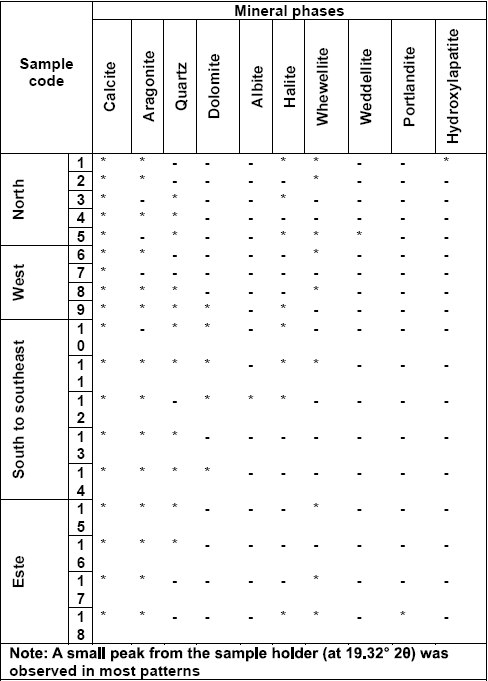
Mineral phases identified in samples from San Carlos Bastion.
Figure 7 Mineral phases identified in samples from San Carlos Bastion: DRX (Analysis: D. Silva, 2013).
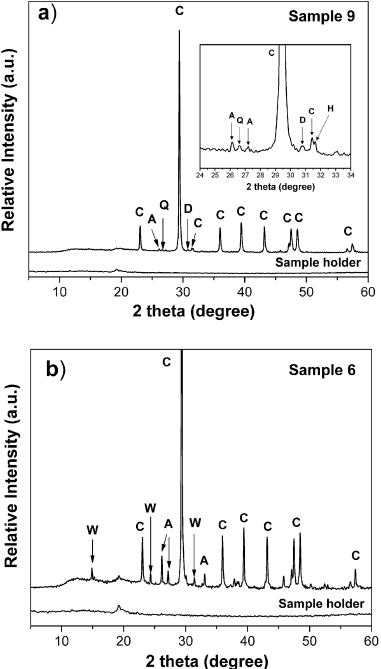
Figure 8 XRD of selected samples from San Carlos Bastion: sample 9 and 6 from Westwall: A=Aragoniter C= Calcite, H= Halite, Q= Quartz, W=Whewellite Dolomite (Analysis: Silva, 2013).
Low intensity peaks of aragonite (CaCO3), quartz (SiO2) and dolomite (CaMg(CO3)2) were also detected. Aragonite, a polymorph of calcium carbonate, is found in bioclastic limestone. Typically it is present in the material quarries used during the building's construction or during later maintenance operations. Quartz and dolomite are common minerals associated with limestone and aggregates (i.e sascab/sahacab, as mentioned, a carbonated clay marl from the Yucatan Peninsula) used to prepare the traditional mortars employed during the construction of the bastion. A wide hump between 10° and 20° 2θ could be related to an amorphous phase.
Traces of halite (NaCl) were found in some samples after careful examination of the X-ray patterns. The main halite peak (at 31.69° 2θ) was observed as a small shoulder at the right side of the 006 calcite peak at 31.42° 2θ (see inset in Figure 8a). Halite identification was difficult in some samples due to the high content and high crystallinity of calcium carbonate. These results are in good agreement with our expectations regarding decay in a marine environment and the elements identified by EDS analysis showed in Figure 5 (Cardell 2003:165). The presence of neomineral phases like whewellite (CaC2O4 .H2O), and weddellite (CaC2O4 .2H2O) was related to the bio-deterioration phenomena (Figures 5b & 7). Calcium oxalates are formed during oxalic acid dissolution of calcareous materials (Ghedini 2006:939). Oxalic acid is produced by the metabolic activity of microorganisms like cyanobacteria and lichens (Arocena 2007:356). Hydroxylapatite (Ca5(PO4)3(OH)) was detected only in sample 1 (north wall). It probably originated from residue of marine shells used as aggregates.5
Portlandite (Ca(OH)2) was present only in sample 12. It is considered a binder, used by Spanish colonizers for stucco and building construction. Portlandite is formed from the reaction of calcium oxide with water; another possible source of it could be the use of Portland cement in the bastion's recent restoration since it is a common hydration product of cement (Kouzeli 1989:327; Polikreti 2003:111; Maravelaki-Kalaitzaki 2005:187; Gaines 1997). Gypsum was not found in any sample. In consequence, the crust present in most of the samples was formed entirely by recrystallized calcium carbonate. The weathering process of historic buildings in San Francisco de Campeche is mostly due to natural factors rather than anthropogenic ones.
Conclusions
This is a pilot study on weathering phenomena in historical buildings in San Francisco de Campeche, Mexico. It is based on several scientific techniques that are used in other countries to evaluate the deterioration of cultural heritage. It provides an excellent insight into the complex factors that are involved in the deterioration of historic buildings in tropical areas of Mexico.
The analysis indicates that water is the key factor in the deterioration of San Carlos Bastion fabric. Water induces neo-formation mechanisms of calcium carbonate, the major component of crust formed over this monument's walls surface. It also involves changes in mechanical properties of mortars and biological activity.
Despite its coastal location, airborne salts do not appear to be the main cause of building deterioration: this finding differs from similar analyses of other coastal sites (Corvo 2008, 2010). The elevated availability of water in the tropical marine environment of San Francisco de Campeche, together with the physical characteristics of the stone material, accounts for this difference.
Karstification appears to be the main weathering degradation mechanism observed at the massive limestone masonry structure of the bastion, a consequence of its long interaction with the particular environmental conditions surrounding the building. The inside structure of the bastion acts like an artificial rock outcrop with well developed caves, reservoirs and drainage systems. It is a potential cause of structural damage to the building.
Mineral characterization also revealed the presence of calcium oxalates including whewellite and weddellite. These minerals are a consequence of biological activity. Moreover, anthropogenic neominerals like gypsum were not identified in the samples. This supports our conclusion that the weathering process of historic buildings in San Francisco de Campeche is primarily caused by natural factors rather than anthropogenic factors.











 nova página do texto(beta)
nova página do texto(beta)


